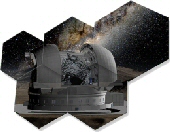Italiano (English below):
La sera del capodanno di questo nuovo 2023, le condizioni meteo e del seeing (stabilità atmosferica) erano eccezionalmente favorevoli qui a Palermo, per cui anche in un giorno molto particolare, non potevo lasciar sfuggire un’occhiata alla Luna, che attualmente figura altissima in cielo alle nostre latitudini.
Ho iniziato la sessione di riprese appunto con la Luna, della quale vi presento una zona molto bella ed appariscente della faccia a noi visibile del nostro satellite naturale: la zona del cratere Platone (Plato) e delle adiacenti Alpi lunari (Montes Alpes).
Sul cratere Platone, di cui ho già parlato lo scorso novembre 2022 (vedi link: https://www.carmelozannelli.com/site/?p=2967) posso solo aggiungere che è già visibile attraverso un buon binocolo da almeno 10 ingrandimenti, conoscendone la posizione lunare.
Vicino al cratere “Plato”, si possono osservare le Alpi lunari (Montes Alpes), una catena montuosa situata sulla superficie della Luna, nella parte settentrionale dell’emisfero sempre rivolto verso la Terra.
Questa catena costituisce il margine nordorientale del “Mare Imbrium” (Mare della Pioggia), pianeggiante e privo di caratteristiche particolari.
La lunghezza totale di questa formazione montuosa è pari a circa 280 chilometri verso il lato nord-ovest e continua in modo intermittente. A Circa a un terzo da sud-est in direzione della lunghezza della catena, si può osservare il Mons Blanc, il picco più alto, che raggiunge un’altezza di 3,6 km. Per confronto, l’altezza tipica dei picchi dei Montes Alpes in questo intervallo, varia da 1,8 a 2,4 km.
Una caratteristica morfologica molto particolare e bella, si inserisce in mezzo alle Alpi lunari: La “Vallis Alpes”, una frattura particolarmente lunga (circa 166 km. complessivi) il cui fondovalle si presenta come una superficie pianeggiante e ricoperta di lava, percorsa da una lunga frattura centrale, larga approssimativamente 500 metri (MOLTO, MOLTO bella, che costituisce un interessante obiettivo di test per osservazioni telescopiche dalla Terra). Le pendici della valle si elevano ai due lati della frattura fino a raggiungere l’altitudine degli altopiani circostanti, dall’aspetto irregolare e frammentato.
A metà strada tra il “Mons Blanc” e il “Promontorium Agassiz” si trova il “Promontorium Deville”, mentre a sud-ovest del Promontorium Agassiz si trova l’isolato “Mons Piton”, un picco molto bello che raggiunge un’altezza di 2,3 km. Tutte le citate formazioni montuose, insieme ai “Montes Teneriffe” – anch’essi molto belli da osservare attraverso un telescopio di almeno 50 ingrandimenti -, fanno parte dell’anello interno del bacino del Mare Imbrium.
Grazie per la Vostra attenzione e…. ad maiora semper!
Dettagli Tecnici:
Telescopio Astrofaktorja DK20″ @ ~ F/27 – Player One Saturn M camera – Televue Powermate Barlow 2x – Baader R filter – Seeing ~ 7,5/10 (max.) in R band – sito: Palermo @ my personal Observatory.
*********************************************************************************************
English:
On New Year’s Eve of this new 2023, the weather and seeing conditions (atmospheric stability) were exceptionally favorable here in Palermo, so even on a very particular day, I couldn’t miss a look at the Moon, which currently figures very high in sky at our latitudes.
I started the shooting session with the Moon, of which here I present a very beautiful and showy area of the face visible to us of our natural satellite: the area of the Plato crater (Plato) and the adjacent lunar Alps (Montes Alpes).
On the Plato crater, which I already talked about last November 2022 (see link: https://www.carmelozannelli.com/site/?p=2967) I can only add that it is already visible through good binoculars with at least 10x magnification, knowing its lunar position.
Near the Plato crater, you can observe the Lunar Alps (Montes Alpes), a mountain range located on the surface of the Moon, in the northern part of the hemisphere always facing the Earth.
This range forms the northeastern edge of the Mare Imbrium (Sea of Rain), flat and devoid of particular characteristics.
The total length of this mountain formation is approximately 280 kilometers towards the north-west side and continues intermittently. At about one-third southeast in the direction of the length of the range, you can see Mons Blanc, the highest peak, which reaches a height of 3.6 km. For comparison, the typical height of the Montes Alpes peaks in this range ranges from 1.8 to 2.4 km.
A very particular and beautiful morphological feature is inserted in the middle of the lunar Alps: The “Vallis Alpes”, a particularly long (about 166 km. in total) whose valley bottom looks like a flat surface covered with lava, crossed by a long central fracture, approximately 500 meters wide (VERY, VERY beautiful, which makes an interesting test target for telescopic observations from Earth). The slopes of the valley rise on both sides of the fracture until they reach the altitude of the surrounding plateaus, which look irregular and fragmented.
Halfway between the “Mons Blanc” and the “Promontorium Agassiz” is the “Promontorium Deville”, while southwest of the Promontorium Agassiz is the isolated “Mons Piton”, a very beautiful peak which reaches a height of 2.3 km. All the aforementioned mountain formations together with the “Montes Teneriffe” – also very beautiful to observe through a telescope of at least 50 magnifications – are part of the inner ring of the Mare Imbrium basin.
Thank you for your attention and…. ad maiora semper!
Technical details:
Telescope Astrofaktorja DK20″ @ ~ F/27 – Player One Saturn M camera – Televue Powermate Barlow 2x – Baader R filter – Seeing ~ 7,5/10 (max.) in R band – site: Palermo @ my personal Observatory.



One Comment
Bravissimo Caro Carmelo, la tua passione è veramente sorprendente anche per chi come me non è esperto in questa materia. Un abbraccio